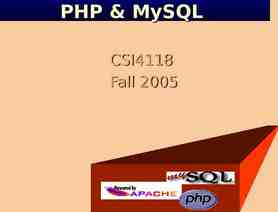Hadoop Distributed Filesystem Spring 2015, X. Zhang Fordham Univ.
17 Slides728.17 KB
Hadoop Distributed Filesystem Spring 2015, X. Zhang Fordham Univ.
MapReduce Programming Model Split Input: a set of [key,value] pairs Shuffle intermediate [key,value] pairs [k1,v11,v12, ] [k2,v21,v22, ] Output: a set of [key,value] pairs
Target Usage of HDFS storing very large files: MB, GB, TB, PB streaming data access: data is write-once and read-many-times; data analysis involve a large potion or all data optimize time to read whole data (from beginning to the end ) Commodity hardware (of various vendors), fault-tolerant
HDFS not suited for Low-latency data access Storing lots of small files incur too much memory overhead in name node (which keeps meta data in memory) Multiple writers can only be written by a single writer (program) Writing to arbitrary offsets in file only support writing to the end of file
File systems blocks Disk drive has a block size (e.g., 512 B) basic unit of data for disk read and write When reading/writing disk, we don’t go by bytes Filesystems blocks, an integral multiple of disk block size, typically a few kilobytes file system space is allocated in terms of block A file is stored as multiple blocks, each stored as independent units (might be in different place in disk) Transparent to filesystem user/programmer: read(), write() calls take any length Commands such as df and fsck, operates on filesystem block level
HDFS blocks 64MB per block by default Files in HDFS are broken into block-size chunks, stored as independent units File smaller than 64 MB does not take a whole block of storage Different blocks of a file can be stored on different nodes. Support very large files Each block replicated (for fault-tolerance and availability) Map tasks normally operates on one block at a time parallel processing, aggregate disk transfer rate
HDFS: NameNode, DataNode Master Worker/Slaves
HDFS namenode Each HDFS cluster has one node operating as namenode (master) Manages file system namespace, i.e., filesystem tree structure metadata for all files/directories: e.g., permission info, owner, last modification time, etc. Above info. stored in namenode’s local disk (i.e., local file system) as two files: namespace image edit log Also cached in memory: where blocks of file are located (reconstructed from datanodes ) HDFS federation: allow multiple namenodes each manage a subspace support larger HDFS
HDFS datanode: worker/slave Stores file blocks and checksum for it. Retrieve blocks when client requests for it Update namenode with block information periodically before updating: verify checksums If checksum is incorrect for a particular block i.e. there is a disk level corruption for that block, it skips that block while reporting block information to namenode. namenode replicates block somewhere else. Send heartbeat message to namenode namenode detects datanode failure, and initiates replication of blocks Talk to each other to rebalance data, move and copy data around and keep replication high.
HDFS namenode error resilience Namenode failure renders whole filesystem useless as it acts as a map to filesystem Ways to make namenode resilient to failure backup to multiple filesystems (local disk, and a remote NFS) secondary namenode periodically merge namespace image and edit log of name node lags behind namenode
HDFS High Availability a pair of namenodes in an active- standby configuration. When active namenode fails, standby takes over its duties to continue servicing client requests without a significant interruption. A few architectural changes are needed to allow this to happen: The namenodes must use highly-available shared storage to share the edit log. (In the initial implementation of HA this will require an NFS filer, but in future releases more options will be provided, such as a BookKeeper-based system built on ZooKeeper.) When a standby namenode comes up it reads up to the end of the shared edit log to synchronize its state with the active namenode, and then continues to read new entries as they are written by the active namenode. Datanodes must send block reports to both namenodes since the block mappings are stored in a namenode’s memory, and not on disk. Clients must be configured to handle namenode failover, which
Outline Design of HDFS HDFS Concepts Command line interface (HDFS commands) URI and various file systems Accessing HDFS through HTTP, i.e., Web UI Java Programming API to HDFS
Access HDFS through commands Pseudo-distributed mode configuration Currently the default setting used Two property: fs.default.name, set to hdfs://localhost/, a default filesystem for Hadoop (i.e., unless otherwise specified, commands are referring to this file system) e.g., hadoop fs -ls // list the default file system Filesystems are specified by a URI: hdfs URI to configure Hadoop to use HDFS by default. HDFS daemons will use this property to determine the host and port for HDFS namenode. (Here it’s on localhost, on the default HDFS port, 8020.) And HDFS clients will use this property to work out where the namenode is running so they can connect to it. dfs.replication set to 1
File System Operations Read files, creating directories, moving files, copying files, deleting files, and listing directories hadoop fs -help ## to see a summary of all filesystem commands % hadoop fs -copyFromLocal input/docs/quangle.txt hdfs://localhost/user/tom/ quangle.txt % hadoop fs -copyFromLocal input/docs/quangle.txt /user/tom/quangle.txt % hadoop fs -copyFromLocal input/docs/quangle.txt quangle.txt Other commands: ls, mkdir [zhang@puppet ] hadoop fs -ls Found 12 items -rw-r--r-- 1 zhang supergroup 1494 2015-01-27 16:20 Filter.class -rw-r--r-- 1 zhang supergroup 1353 2015-01-27 16:20 Max.class drwxr-xr-x - zhang supergroup 0 2015-01-18 16:37 in0 drwxr-xr-x - zhang supergroup 0 2015-01-13 17:36 input drwxr-xr-x - zhang supergroup 0 2015-01-18 16:35 ncdc drwxr-xr-x - zhang supergroup 0 2015-02-03 20:37 out2 drwxr-xr-x - zhang supergroup 0 2015-02-03 19:21 out3 drwxr-xr-x - zhang supergroup 0 2015-01-18 16:46 out streaming drwxr-xr-x - zhang supergroup 0 2015-01-18 16:58 out streaming new drwxr-xr-x - zhang supergroup 0 2015-01-28 16:35 out streaming new3 drwxr-xr-x - zhang supergroup 0 2015-02-08 14:04 output drwxr-xr-x - zhang supergroup 0 2015-01-27 16:00 record count
Pseudo-distributed mode To check whether they are running: ps -aef grep namenode
Outline Design of HDFS HDFS Concepts Command line interface (HDFS commands) URI and various file systems Accessing HDFS through HTTP, i.e., Web UI Java Programming API to HDFS Code walk-through Learn from example Codes Use the Apache online manual for MapReduce API
Apache Hadoop Main 2.6.0 API For now, focus on Package org.apache.hadoop.mapreduce (replace org.apache.hadoop.mapred). Use Index to look up class/interface by name Mapper, Reducer: a generic type (C template class) with type parameters TextInputFormat, default InputFormat used by mapper, decides how input data is parsed into key,value pairs






















